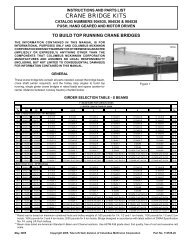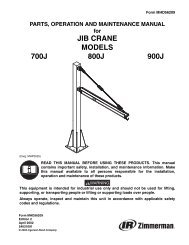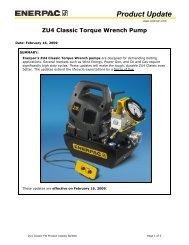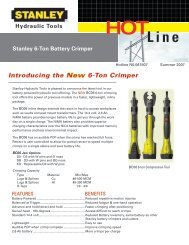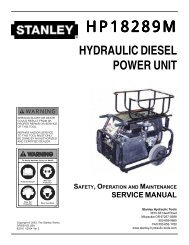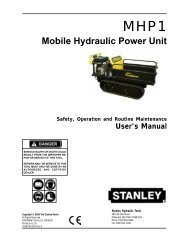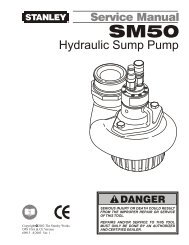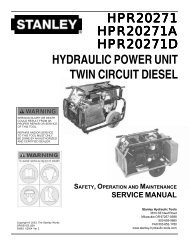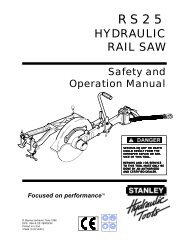Hydraulic Sinker Drill - Tool-Smith
Hydraulic Sinker Drill - Tool-Smith
Hydraulic Sinker Drill - Tool-Smith
Create successful ePaper yourself
Turn your PDF publications into a flip-book with our unique Google optimized e-Paper software.
13<br />
accumulator. If the washer is not properly located,<br />
the parts will be damaged. If the entire accumulator<br />
assembly is removed, proceed to step 14. If the<br />
accumulator cylinder (22) remains in the accumulator<br />
housing, it can be removed using the following<br />
procedures.<br />
a. If the entire accumulator assembly was removed,<br />
skip this step and proceed to step 14.<br />
Assemble the Stanley special accumulator<br />
cylinder puller tool (p/n 05640) to a slide<br />
hammer containing a 1/2 inch diameter shank.<br />
Insert the puller tool into the bottom of the<br />
accumulator cylinder so that it seats on the<br />
inside lower contour of the cylinder. Hammer<br />
the cylinder out of the accumulator housing.<br />
14. Remove the tube connector (102) by pulling it out of<br />
the accumulator chamber.<br />
15. To remove the accumulator chamber and<br />
diaphragem (23) from the accumulator cylinder,<br />
place the accumulator assembly on Stanley special<br />
disassembly tools (p/n 05508 ring and p/n 04910<br />
tube). Place a rag in the bottom of the tube to protect<br />
the accumulator chamber when it is removed. Drive<br />
the chamber and diaphragm out of the cylinder by<br />
tapping on the charge valve end of the chamber with<br />
a maller or pushing on it with an arbor press.<br />
16. Squeeze the accumulator diaphragm and slide it off<br />
the charge valve end of the accumulator chamber.<br />
17. Remove the cup seal (26) and back-up washer (25)<br />
from the accumulator chamber.<br />
18. Remove the air tube (1) (or water tube if applicable).<br />
ACCUMULATOR RE-ASSEMBLY<br />
1. Apply grease and install a new o-ring (100) into the<br />
groove on the accumulator chamber. NOTE: This oring<br />
was only used on early models. It was eliminated<br />
on later models.<br />
2. Apply a light coating of WD-40 to the accumulator<br />
diaphragm (23) and accumulator chamber (24).<br />
Slide the accumulator diaphragm onto the accumulator<br />
chamber from the tube connector (102) end.<br />
3. Use grease or rubber lubricant on the inside of the<br />
accumulator cylinder (22) and the outside diameter<br />
of the diaphragm. Push the accumulator chamber<br />
and diaphragm, tube connector end first, halfway<br />
into the accumulator cylinder. Be sure the accumulator<br />
diaphragm is free of wrinkles and the seal beads<br />
are seated correctly to the accumulator chamber<br />
before completing the assembly. Use an arbor press<br />
to completely seat the assembly using short movements<br />
during the last 1/2 inch/12 mm of travel to<br />
gently seat the diaphragm.<br />
4. Apply grease and install a new o-ring (21) into the<br />
groove on the accumulator cylinder.<br />
5. Apply grease and install the back-up washer (25)<br />
and a new cup seal (26) (lips facing out) in the<br />
accumulator chamber counterbore.<br />
6. Apply grease and install new o-rings (101) into the<br />
grooves on the tube connector. Install the tube<br />
connector into the accumulator chamber.<br />
FLOW SLEEVE, PISTON, & AUTOMATIC<br />
VALVE RE-ASSEMBLY<br />
The best way to assemble the flow sleeve (31), automatic<br />
valve body (56) and piston (29) is by using an<br />
assembly fixture such as that shown in figure 1. The<br />
fixture permits the parts to be stacked vertically during<br />
the assembly process. After the parts are stacked, the<br />
handle assembly can then be placed on top of the<br />
stacked parts and tapped into place.<br />
The assembly fixture shown in figure 1 should be<br />
constructed of aluminum or brass and should be at least<br />
3-1/2 in/88 mm high but no more than 8 in/203 mm<br />
high.<br />
Figure 1.<br />
1. Lubricate the flow sleeve with clean hydraulic fluid<br />
and install it into the flow sleeve tube (30). The flow<br />
sleeve has a wide groove around the outside of one<br />
end. Install this end first. Then place the flow sleeve<br />
tube and flow sleeve on top of the assembly fixture<br />
shown in figure 1.




